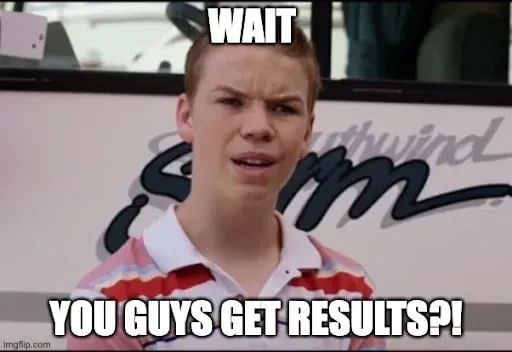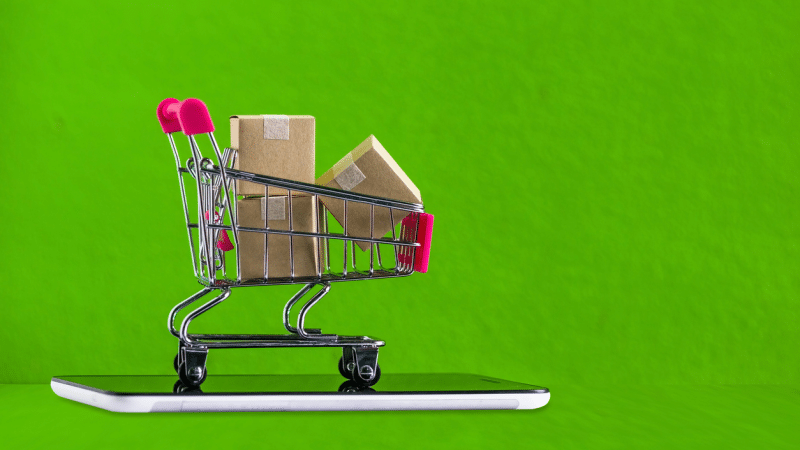“I spent $600 this week and not even one sale. What am I doing wrong?”
Since the iOS update and the slow but steady disappearance of cookies, eCommerce brands have seen a dramatic decrease in their ROI.
In fact, it seems like every number goes down – except for the $$$ invested in Facebook ads.

Given the situation, you might feel tempted to abandon the ship. Move on to another hot new Social Media channel…or even go old-school with flyers and leaflets.
However, Facebook ads are still great. Especially for brand awareness and targeting people who fit your Ideal Customer Profile.
Your real problem isn’t necessarily the lack of data brought by all the latest updates in eCommerce. It’s the sheer volume of Facebook eCommerce Ads running on the platform.
Buyers get tired or used to the same sorts of ads.
So you need to optimize your Facebook eCommerce Strategy – and approach your Facebook ad campaigns from a customer-centric view.
Successful ads strategies for eCommerce are less focused on the product and more on the customer experience with said product.
If you want your ads to drive sales, get comfy and read this article. You’ll discover Strategies, Examples, and Tips to nail the Ads for eCommerce Strategy.
Why do you Need a Facebook eCommerce Strategy?
Let’s face it.
eCommerce Facebook Ads will always be around.
People will always shop online. Even more so after the pandemic, when online shopping was the only option. So now it’s the norm.
The problem now isn’t that people won’t shop online. The problem is the competition.
If you outbid it, good job! You’ll get better results.
If not…better luck next time, right?
Facebook Ads are an Auction-type system. Those who spend the most win the auction.
But what happens when you don’t have hundreds of dollars to invest in your product ads? Are you supposed to stay off Facebook or declare defeat?
Of course not -you would go bankrupt.
And here’s why you need a solid strategy for eCommerce ads on Facebook.
Use Great Pictures
You can’t even pronounce the words “Facebook ad tips” without being advised to use imagery. And for great reason.
87% of online shoppers said the product images were a big part of their buying decision.
Using high-quality images with your Ads is a no-brainer.
Your existing and potential customers are spending a big chink of their days on Facebook, exposed to approximately 5000 ads/day.
It takes 1-2 seconds for someone to get hooked by an ad and stop scrolling. So, how do you take advantage of this brief timeframe?
Through bold imagery.
No matter the types of ads you are running, visual creatives are the perfect way to showcase your products, evoke an emotion, or just stand out in the Feed.
Invest in a photoshoot, hire a graphic designer, and tweak your creatives until you get the best results.
You can use many types of images in your running Ads, so let’s take a look at some of them.
Product Photography.
This one is mandatory.
Prove your products are authentic and help the prospects envision using your products with beautiful product shots.
You should take and upload these pictures in high resolution and from many angles to showcase their beauty.

Infographics
Currently, carousel ads with up to 5 infographics are viral on Social Media.
With infographics, you can express an idea or a complicated concept better. Or, you can use them as a summary of your copy to help the prospect better process the information.
Lifestyle images
Besides product photography – for showcasing your products – and infographics – for explaining complicated concepts – lifestyle images are also trendy today.
Behind a buying decision, you have a vision. A consumer is imagining a future version of him, in the not-so-distant future, where he’s using your products and enjoying them.
So, help him envision this future.
Use lifestyle shots showcasing how your products work. It also helps with trust – since many eCommerce ads are too much about the products and too little about the people using them.
Like what you're reading?
Join the informed eCommerce crowd!
We will never bug you with irrelevant info.
By clicking the Button, you confirm that you agree with our Terms and Conditions.
Pro tip – you can showcase how your product is being used through a video ad. Humans process information through video better and more accessible, which is why video ad formats reign supreme nowadays.
(and let’s face it: it had been for a while.)
Get Facebook Pixel for your Website
Your Facebook strategy for acquisition and retention must include the Pixel.
Formerly known as Facebook Pixel, the Meta Pixel is a piece of code. You can install it on your website, Shopify store, or any other custom store you have.
This piece of code then lets you measure, optimize and build target audiences for your advertising campaigns.
It’s a must-have, free tool that allows you to better understand customer behavior on your website.
Each time a visitor takes action, the Pixel reports this info. Here are the main actions (or events) you can track with Facebook Pixel:
- Purchase.
Self-explanatory. Someone buys something from your online shop.
- Payment info added.
A shopper inserts their info (name, address, credit card number) while purchasing something from your online store.
- Add to cart.
A visitor places the product in their cart.
This doesn’t mean they will go through with the purchase. Sometimes users treat the shopping cart like a wishlist.
However, knowing the products they’re interested in helps you create dynamic remarketing campaigns. More on this soon.
- Initiate checkout.
The visitor starts the checkout process. The easier the checkout, the more chances the visitor will convert and follow through with the purchase.
- Search.
The visitor searches for a specific product in your eCommerce store.
Tracking this activity helps you take the market pulse and understand which are the products needed by your customer base.
- Customize products.
The visitor selects a specific model of a product. They might choose a particular size or an exact print.
Of course, the Meta Pixel can track more events (such as subscriptions or visitors contacting your business).
Yet, for your customer acquisition campaigns, these actions should be enough.
It’s dangerous to base your marketing strategy on gut feelings or trying to guess what customers need from you. You should make data-driven decisions to unlock growth for your eCommerce business.
When running Facebook Ads, these decisions mean creating custom audiences and targeting specific website visitors (with a particular behavior).
When more and more visitors purchase a product and become customers, Facebook gets better at targeting new potential customers with future ad sets that match the behavior and targeting of your existing customers.
Pro tip: use Omniconvert Reveal’s Audience Builder to create even better Facebook audiences using the data from your store! The Audience Builder collects your data, creates profiles based on it, then sends the profiles directly to Facebook. This way, you can run dynamic Ads in a “set-it-and-forget-it” manner.
Target Potential Shoppers who are Dissatisfied with Competitors
When it comes to Facebook Ad Strategies, this one is the trickiest.
Do it right, and you can steal customers from your competitors, grow your revenue, and earn market share.
Do it wrong, and you end up inside a bidding war you cannot afford.
It may seem sketchy, but remember that people leave brands because of bad experiences. In other words – you can’t steal someone who isn’t planning on leaving.
So, how do you approach it?
The first step is creating a list of specific competitor pages.
Try to pick competitors who play on the same level as yours. If you’re a rising retailer, don’t go after established enterprises. And vice versa.
After your list is made, it’s time to create ads targeting your competition’s specific audience.
Of course, you can’t target them directly; Facebook doesn’t allow you to target someone who bought from a specific company.
However, a little trick to reach this audience is Targeting by Interest.
When creating your custom audience inside Facebook’s Ad Manager, simply type in your competitor’s name in the “Interests” section.

This option allows you to target people interested in your competition. While you can’t know for sure whether they are actual customers or only fans of the brand, it still gives you a chance to “steal” these customers.
Remember – this strategy’s success depends on how good the competition is at providing Customer Lifetime Value.
Afraid this can happen to your business? Then, stand up from the crowd and start investing in the relationships with your customers. Check out Omniconvert’s Free Course on Customer Lifetime Value and become a brand everyone loves!
Get Potential Customers Who Visited Your Store Once
Your Ads strategy should definitely include retargeting campaigns.
Retargeting Ads are those Facebook ad types that bring people to your shop.
Use the collected data to bring back cart abandoners, one-time visitors, or people who search or customize products but don’t complete the purchase.
Let’s look at these strategies examples that use retargeting Ads:
- Abandoned Cart
This is a problem most eCommerce Facebook advertisers can relate to.
You bring someone to your website, they’re adding products to the cart, but they don’t proceed to checkout and complete the purchase.

Perhaps they got distracted, weren’t yet ready to buy, or were annoyed with a complicated checkout process.
Retargeting is handy here for Facebook eCommerce marketers because these Ads can showcase to visitors the specific products they added to the cart but abandoned.
Pair the ad with the scarcity principle (reduce the shoppers’ access to a certain product), and your Conversion Rate will improve.
- Discounts
Facebook advertisers and eComm businesses should reward their loyal customers with special treatment and discounts.
Suppose you perform an RFM analysis and identify your high-value customers. In that case, you can target them with specific ad sets that show people the items they’re most interested in.
Use Facebook Dynamic Ads* to surprise your customers with discounts for their favorite products, special offers, or extra perks to thank them for their patronage.
*Dynamic ads automatically adapt content and promotions specifically to each user.
Pro tip – your best customers are your benchmark when creating lookalike audiences.
Lookalike audiences target people most similar to your existing customers (share specific characteristics).
And you’ll maximize your results if you emulate your best customers instead of targeting all people inside your customer base. You can use RFM Segmentation to identify your best customers and bet on the winning horse, so to speak.
- Upsell
You can also use retargeting to push similar or complementary products onto your customers.
For example, suppose someone bought a Polaroid Camera you Advertised on Facebook. In that case, they will also need paper to print their photos.
Target the person who bought the camera with an Ad for papers, and you get more value from the first purchase.
This works with any products that can be bought in bulk or are complementary to each other.
Tweak Your Website
While not a Facebook Strategy, optimizing your website for conversion is still a crucial step if you want to earn more customers.
If your Ads are converting, but you don’t see new customers, it means the problem is with the shop. Ask yourself these questions:
Does my shop inspire trust?
Humans are naturally suspicious and afraid of losing their money and time. Trust is not quickly earned, so you should do everything in your power to reassure shoppers and reduce friction points.
Reviews, testimonials, high-quality product pictures, and a professional-looking website all contribute to establishing trust.
How intricate is the buying process?
Some retailers make it really easy for shoppers to make a purchase. Some overcomplicate the process and lose traffic because of it.
The buying process should be easy and intuitive.
✓ Visitor sees the product.
✓ Visitor adds the product to the cart.
✓ Visitor inputs his info and places the order.
Every extra step is useless. So make sure your Add to cart buttons are clear and visible, and the checkout page is minimalistic. Don’t overcrowd it with upsells, or too many forms, because the visitor will get distracted and abandon the purchase.
Is my shop customer-oriented?
You might fall into the trap of overexplaining your products or brand story and forget the real hero: the customer.
Everything on your website – from the copy to the colors, should be customer-oriented.
Always explain what’s in it for them; if they become your customer, be quick to solve their issues and provide seamless experiences.
Wrap-up: Acquisition still matters in 2022
You could pay an average effort and get excellent results a couple of years ago.
Now it’s the opposite: even excellent efforts sometimes bring average results.
While we’re strong advocates for retention and Customer Lifetime Value, the truth is – acquisition still matters.
Even if it’s expensive, even if eCommerce marketing isn’t as friendly as it used to be.
You might need to work 10x more to run successful campaigns, but it doesn’t mean you should quit.
Your customers and potential customers exist on Social Media and search for your products to solve their problems and fill their needs.
You need to meet them halfway with customer-oriented ads and compelling copy.
May your Ads be ever in your favour!
Frequently Asked Questions about Facebook Ads for eCommerce
Which Facebook ads are most effective for eCommerce?
eCommerce businesses see higher ROI when running dynamic ads. Combined with laser-focused targeting, dynamic ads allow you to advertise the right product, to the right people, at the right time.
What are some tips for making effective Facebook ads?
Make sure you use bold imagery and high-quality product pictures. Instal Facebook Pixel on your shop to track and target better. Update your copy according to your Ideal Customer Profile.
How do I advertise my eCommerce on Facebook?
Start by identifying your target audience and make sure the creatives are tailored to this audience. Use lookalike audiences based on your best customers. Use retargeting Ads to bring back cart abandoners.
Are Facebook ads good for eCommerce?
Even if costs are surging, Facebook ads are still great. Especially for brand awareness and targeting people who fit your Ideal Customer Profile. The trick is narrowing your focus – from trying to reach everyone, to only focusing on people who most likely need your product.
Do Facebook ads work for eCommerce?
With the right creatives and smart targeting, Facebook ads can be an incredible source of revenue for your business. However, competition is fierce, so make sure you do your due diligence in researching your Ideal Customer, as well as best practices to advertise on Facebook.
Which Facebook ad is best for eCommerce?
Video Ads are the most preferred – by the algorithm and users alike. Moreover, businesses see higher ROI when running dynamic ads. Combined with smart targeting, they allow you to advertise the right product, to the right people, at the right time.
How do I run an eCommerce ad on Facebook?
Create your account in Ads Manager. Select your objective, audience and budget. Create the Ad with your creatives. Constantly monitor the results while the Ad is running. Optimise if needed.
What is the conversion rate of Facebook ads for eCommerce?
It depends on your budget, type of products you’re selling, and even the country you’re operating in. However, the eCommerce average is 9.2%.